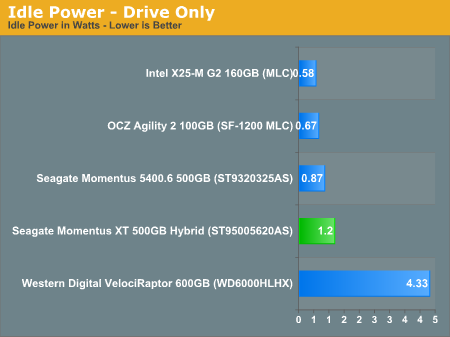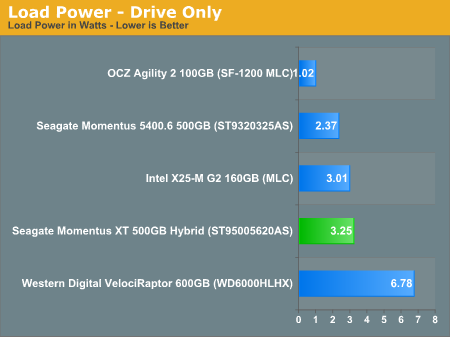Seagate's Momentus XT Reviewed, Finally a Good Hybrid HDD
by Anand Lal Shimpi on May 24, 2010 9:31 AM EST- Posted in
- Storage
- SSDs
- Seagate
- Momentus XT
- Hybrid Drive
- SSHDs
Power Consumption
Compared to the Seagate Momentus 5400.6 the XT uses considerable more power. Only when reading out of the NAND would I expect lower power consumption. What this means is that depending on your workload you might see worse notebook battery life with the Momentus XT compared to a mainstream drive. For the majority of usage models I'd expect equal if not better battery life with the Momentus.

With only the NAND active the Momentus XT draws as little as 0.61W.

Compared to an high end SSD though, the Momentus XT is still more power hungry.










120 Comments
View All Comments
codedivine - Monday, May 24, 2010 - link
Another request is to compare performance against a non-hybrid 7200rpm Momentus, which is the same drive minus the flash. That will make the performance benifits clearer.Ralos - Monday, May 24, 2010 - link
How come a Velociraptor is faster the second time, just after a reboot?It should be the same each time, should it not?
UltraWide - Monday, May 24, 2010 - link
It's due to the fact that it's a mechanical drive with moving parts. At some times the head might be positioned closer to the data requested resulting in improved performance whereas other times it may have to wait for the next revolution to come to the same data. This creates slight variations in performance.icrf - Monday, May 24, 2010 - link
I don't think that makes sense. The second and third runs are consistently faster than the first run, and relatively consistent with each other. What causes a purely mechanical hard drive to learn?kmmatney - Monday, May 24, 2010 - link
I agree - the velocirapter should have parked its read head between boots, so it really shouldn't have been faster between the runs. It must have some tricks.Anand Lal Shimpi - Monday, May 24, 2010 - link
That would be Windows 7's SuperFetch at work.bitterman0 - Monday, May 24, 2010 - link
Actually, I was thinking about comparing this hybrid drive to Windows' own methodology of clustering frequently used data on a USB Flash drive (ReadyBoost, is it?). Granted, USB Flash is not as fast as this on-board SLC, and as far as I understand ReadyBoost is using USB Flash for lower latency purposes only. Yet, from what I hear ReadyBoost helps quite a bit in the OS boot process.But then I've noticed this reply indicating that SuperFetch was NOT disabled in any of the tests. Well, that pretty much invalidates all results obtained in the tests, don't you think? With 4GB of RAM, SuperFetch overrides much of 4GB of read-only NAND cache, and most likely confuses the cache controller. Have the test configuration had 8GB (or more) RAM, the situation would have been much worse still.
Is there a possibility to redo the same tests with SuperFetch turned OFF? That would be a synthetic benchmark for Windows Vista and Windows 7 users, but it will be closer to reality for Windows XP, Windows Server and non-Windows users.
leexgx - Monday, May 24, 2010 - link
you need to disable the ready boot or ready boost (i got to go out now so not going to check logs to what is doing the boot optimization) as i see 400mb or so of ram been free up after 20-30 secs after desktop is shownjaydee - Monday, May 24, 2010 - link
Does SuperFetch play the same role on the Momentus XT? Is someone were running WinXP, would we then expect the boot times to be about the same as the Velociraptor, and both of these have the same boot times no matter how many times you rebooted?void2 - Monday, May 24, 2010 - link
Not exactly. This is the result of ReadyBoot (improved version of "boot prefetch" from Windows XP).SuperFetch in Windows 7 is not even active for a few minutes after boot (unlike, alas, Vista).